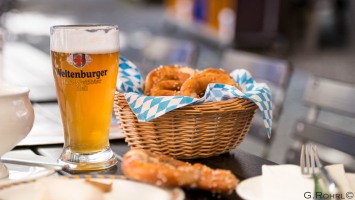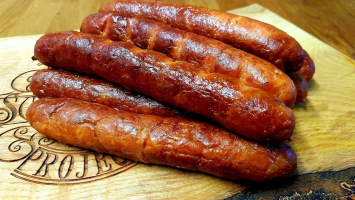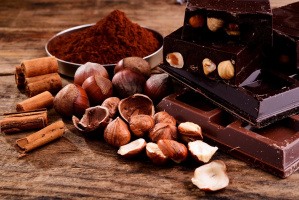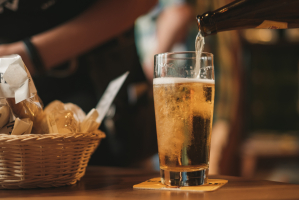Top 10 Famous German Sausage Brands
When people think of Germany, they usually think of beer, pretzels, and sausage. While beer is what Germany is mainly known for worldwide, no breakfast is ... read more...complete without a German sausage to complement it. But German sausages extend beyond the basic backyard barbecue bratwurst that so many people know and love. Let's discover some famous German sausage with Toplist.info!
-
Bratwurst is a type of German sausage made from veal, beef, or most commonly pork. Bratwurst is derived from the Old High German Brätwurst, from brät-, finely chopped meat, and Wurst, sausage, although in modern German it is often associated with the verb beaten, to pan-fry or roast. Beef and veal are usually incorporated amongst a blend often including pork.
What was once an item for survival during the cold winter months and a technique of not wasting meat scraps is nowadays a delicacy consumed throughout Germany and abroad. Bratwurst has origins with the Celtics, but the Franconians developed it further. It dates back to the 1300s in a region that would eventually become Eastern Germany. Bratwurst is usually consumed for breakfast due to the tradition of farmers who would make the sausages in the morning and eat them by noon, as they would otherwise spoil.
The oldest recipe for bratwurst was discovered in 2000 by a historian named Heinrich Höllerlhas. The Thuringian bratwurst (one of the most famous varieties) says that the makers had to use only the purest, unspoiled meat in the production process. Today, bratwursts are commonly served with sauerkraut, potato salad, horseradish, or mustard in Germany, but the sausages are also popular in the United States, especially in Wisconsin, where they are commonly found at summer cookouts and barbecues.
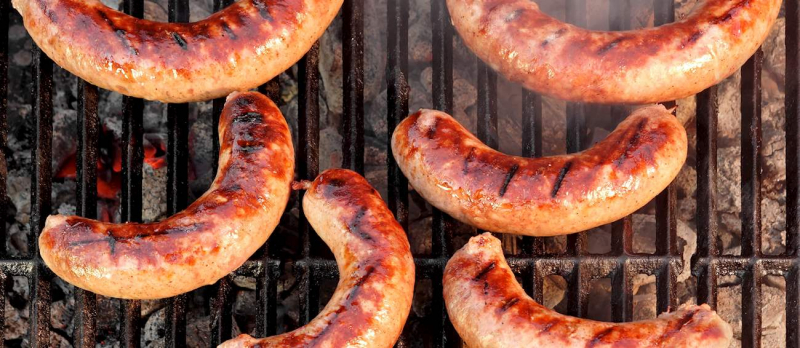
Bratwurst 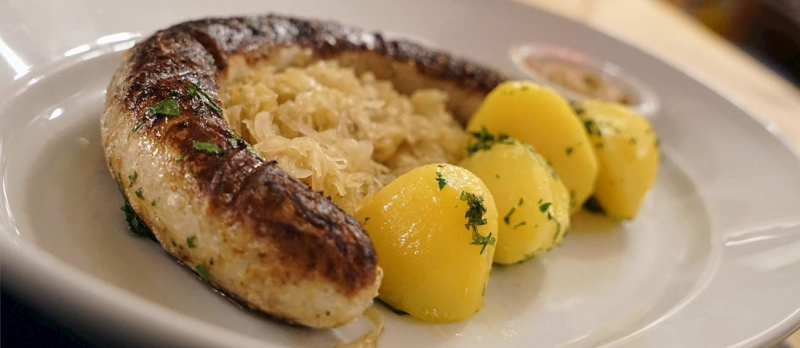
Bratwurst -
Currywurst is a fast food dish of German origin consisting of steamed, and fried pork sausage typically cut into bite-sized chunks and seasoned with curry ketchup. A sauce based on spiced ketchup or tomato paste topped with curry powder, or ready-made ketchup seasoned with curry and other spices. The dish is often served with fries.
The most famous legend tells the story of Herta Heuwer, a Berlin local who is widely credited as the inventor of the tomato and curry concoction. In 1949, amid the aftermath of World War II, many ingredients were hard to come by and life was tough. However, thanks to Herta’s negotiating skills, she was able to get hold of a hard to come by ingredient – British yellow curry powder. She then mixed it with pureed tomatoes and other spices to create the base sauce, which she served with the sliced sausage. The dish became an instant success. Herta patented her creation and never revealed her original recipe. Later, as currywurst grew in popularity, numerous varieties popped up all over Berlin and the rest of Germany. No two are the same, and every local has their favorite style and a favorite currywurst place.
With a portion of french fries or a kaiser roll on the side, the dish is usually lightly dusted with yellow curry powder. A wide range of sausages are used for currywurst, but the famous German bratwurst is the most commonly used variety. Germans are so fond of this fast food staple that they have even built a museum in its honor. Located in Berlin, the Currywurst Museum offers a glimpse into the history of the legendary currywurst, as well as a detailed overview of the numerous varieties, cooking styles, and serving options of this famous dish.
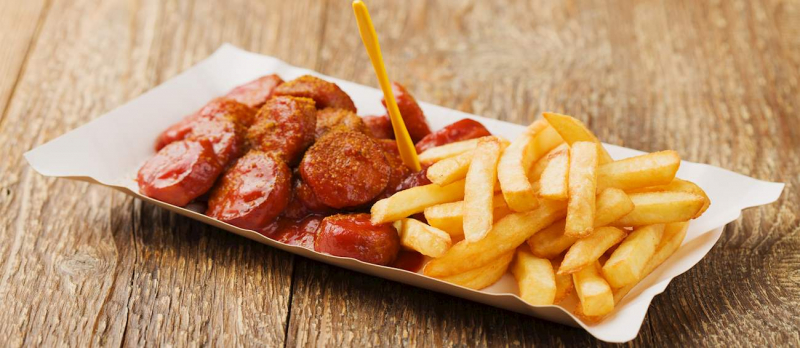
Currywurst 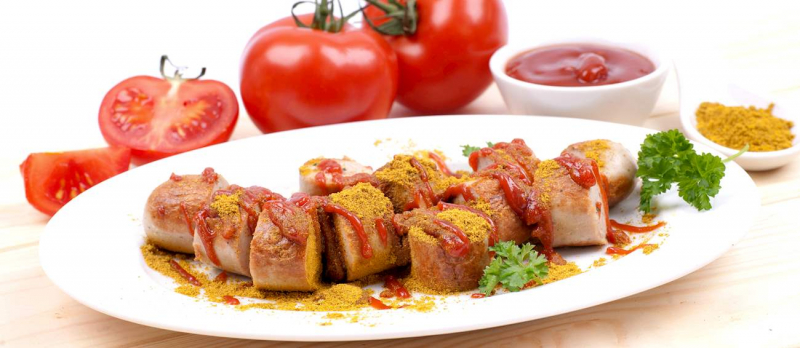
Currywurst -
Weißwürste or white sausage is a famous specialty of Munich, invented in 1857 by a butcher named Sepp Moser. He was working in a restaurant next to his butcher's shop and had used the last of thick sausage skins used to make regular sausages. To solve the problem, he opted for thin skin. As he made the sausage, he was worried that it would burst open during the frying process, so he put them in hot water and cooked them for 10 minutes. After serving the cooked sausages to the guests, the new dish, and being praised, Weißwürste was born in restaurants.
The sausages consist of a mixture of pork, veal, and pork fat, seasoned with parsley, pepper, lemon, and salt. Today, the sausages are most popular in southern Germany, and they are one of the most consumed items at Oktoberfest. In restaurants, Weißwürste is always served hot, usually accompanied by pretzels and ideally, Händlmaier's Hausmacher Senf. Although it can be served with other Bavarian sweet mustard varieties if the original Händlmeier brand is unavailable.
The sausage casing is not intended for consumption, so the sausages are often sliced along their length, and the casing is peeled. Interestingly, it is considered taboo to eat Weißwürste afternoon in Bavaria.
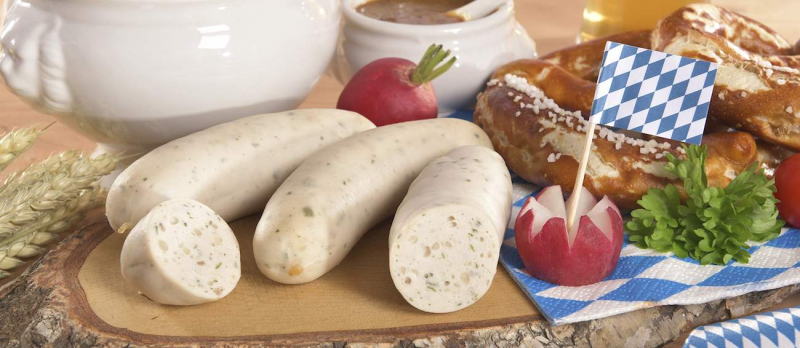
Weißwürste 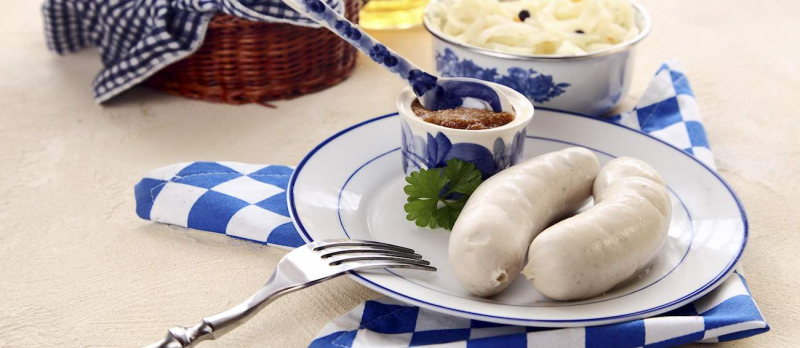
Weißwürste -
Leberwurst or liver sausage is a kind of sausage made from liver. It is eaten in many parts of Europe, including Austria, Bulgaria, Croatia, the Czech Republic, Denmark, Finland, Germany, Romania (especially in Transylvania), Russia, Sweden, Ukraine, United Kingdom...; it is also found in North and South America, notably in Argentina and Chile.
Some Leberwurst varieties are spreadable. Leberwurst usually contains pigs' or calves' livers. Other ingredients are meat (notable veal), fat, and spices including ground black pepper, marjoram, allspice, thyme, ground mustard seed, or nutmeg. Many regions in Germany have distinct recipes for Leberwurst. Adding ingredients like onion or bacon to the recipe makes each variety of Leberwurst very important to cultural identity.
Leberwurst is a spicy German sausage consisting of ground pork liver, onions, and spices. The sausage is traditionally consumed with sauerkraut, although it can also be used in sandwiches, where Leberwurst is sliced and paired with cheese, mustard, pickles, and bread.
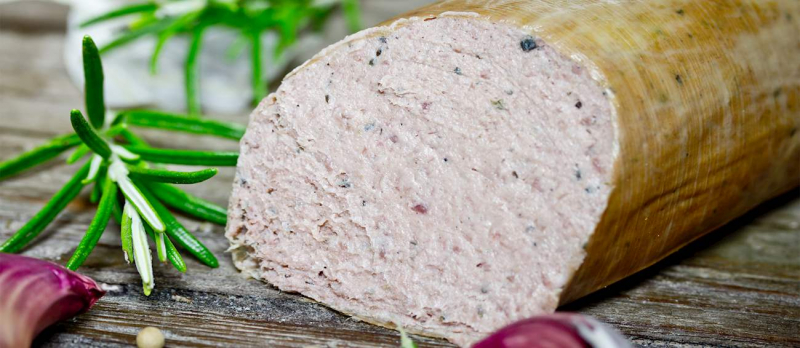
Leberwurst 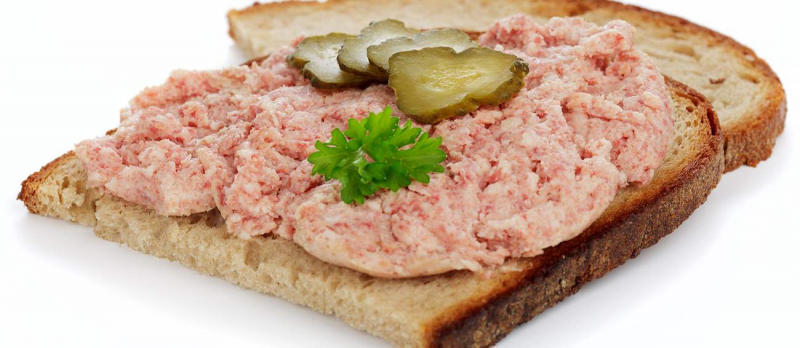
Leberwurst -
Blutwurst is a sausage filled with blood that is cooked or dried and mixed with a filler until it is thick enough to solidify when cooled. Pig, cow, horse, donkey, sheep, chicken, duck, and goat blood can be used, varying by country. In Europe and the Americas, typical fillers include meat, fat, suet, bread, cornmeal, onion, chestnuts, barley, oatmeal, and buckwheat. On the Iberian Peninsula and in Latin America and Asia, fillers are often made with rice. Sweet variants with sugar, honey, orange peel, and spices are also regional specialties.
In many languages, there is a general term such as blood sausage (American English) and blood pudding (British English) that is used for all sausages that are made from blood, whether or not they include non-animal material such as bread, cereal, and nuts. Belonging to the category of cooked sausages, Blutwurst is a famous German blood sausage with many regional varieties. It is predominantly made with pork and incorporates animal blood, fat, and meat, next to a wide variety of seasonings such as marjoram, allspice, and thyme.
Though already cooked and "ready to eat" it is sometimes served warm and similar in France. In the Rhineland, where it is also traditionally made from horse meat, fried Blutwurst is a constituent of various dishes. In Cologne, the traditional Himmel und Erde (Heaven and Earth) combines apple sauce, mashed potatoes, and Blutwurst served hot on one plate. In Berlin, hot Blutwurst mixed with liverwurst and potatoes is called "Tote Oma" ("Dead Grandma").
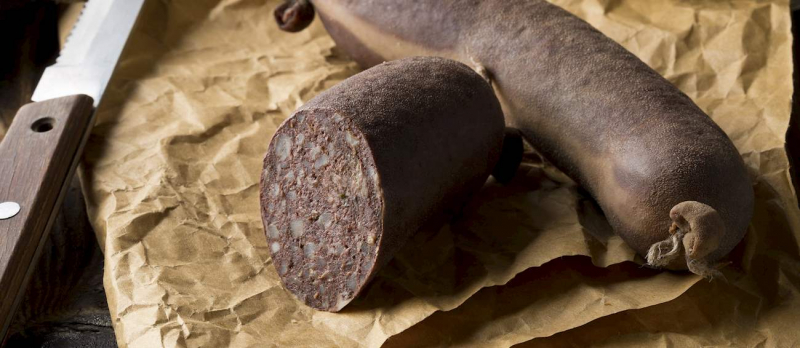
Blutwurst 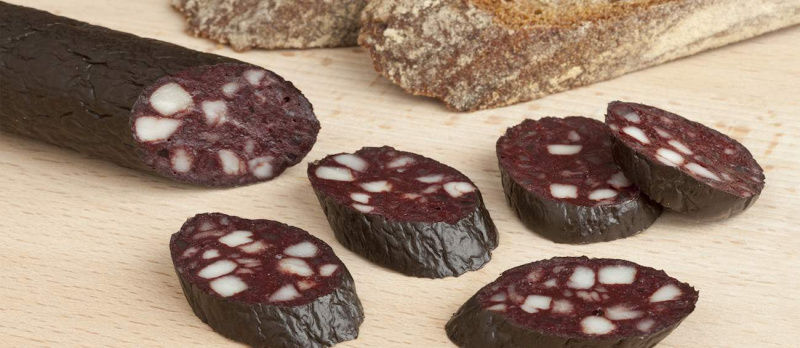
Blutwurst -
Bockwurst is a German sausage traditionally made from ground veal and pork (tending more towards veal, unlike bratwurst). Bockwurst is flavored with salt, white pepper, and paprika. Other herbs like marjoram, chives, and parsley, are also often added.
Bockwurst was originally said to have been eaten with bock beer. In Bavaria and Berlin, it was sold during the bock beer season. Nowadays' you can buy Bockwurst all year round almost everywhere in Germany in butcher's shops, cheaper restaurants, snack bars, food booths, some bakeries, and gas stations.
As a natural casing sausage, it is usually cooked by simmering or steaming although it may also be grilled. Boiling is avoided as the casing may split open and the Bockwurst may look unappetizing and lose flavor to the cooking water. A usual portion consists of one Bockwurst with mustard and a bread roll or potato salad on a plate. However, sometimes, the Bockwurst is served directly in the bread roll and covered with mustard. In some regions of Germany, potato soup is served with Bockwurst
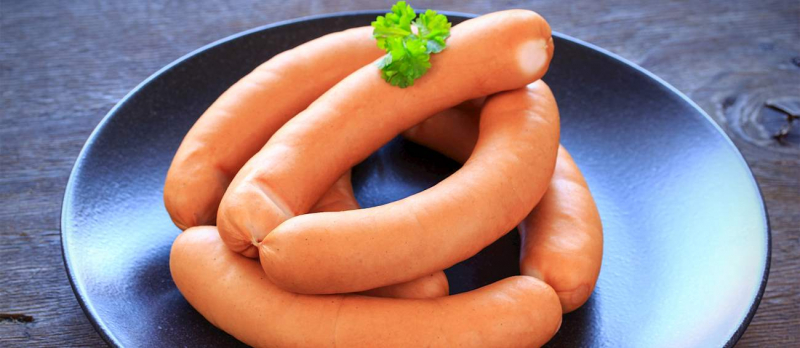
Bockwurst 
Bockwurst -
Knackwurst refers to a type of sausage of northern German origin from the mid-16th century. Knockwurst or knackwurst is a preboiled sausage made from ground pork, beef, or a combination of both.
The sausage is heavily seasoned with garlic and has a high-fat content. Unlike bratwurst and other similar sausages, Knackwurst's casing becomes extra crispy when heated, giving it a different texture and a specific sound when bitten into it. Numerous regional varieties of Knackwurst exist in Germany. They all differ from Knackwurst varieties sold in Austria. There, a Knackwurst always refers to a sausage containing bacon and added potato starch. In addition to the term "Knackwurst", common names are "Salzburger" or "Schübling".
As a specialty in Hamburg, scalded Knackwurst served with mustard and half a slice of white bread is a popular snack for lunch. It is also sold at the Hamburger Dom, the largest Volksfest in northern Germany, under various, sometimes poetic, names like Domknacker, Hamburger Knacker, or Hafenlümmel. It is recommended to serve the sausage with sauerkraut, potato salad, pickles, mustard, and a glass of cold beer on the side.
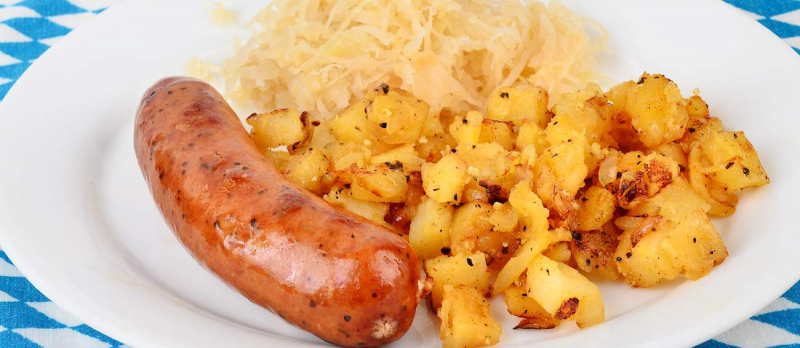
Knackwurst 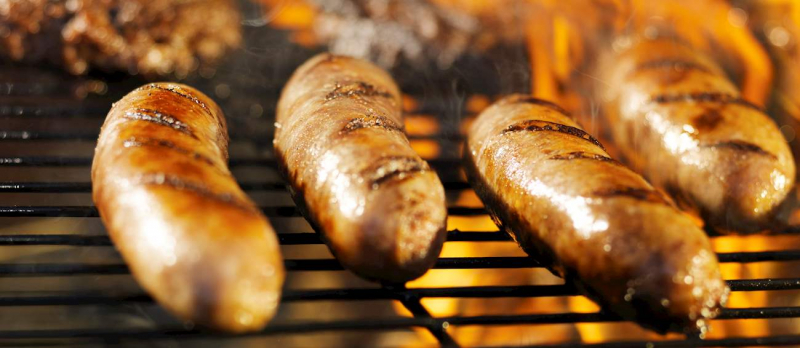
Knackwurst -
Mettwurst is a long and thin German sausage made with a combination of pork and beef, flavored with anything from garlic, pepper, marjoram, caraway, and mace to alcoholic beverages such as rum and cognac. Mettwurst is partially smoked but still soft and spreadable, while other northern German varieties such as Holsteiner are harder and more akin to salami due to the longer duration of smoking.
The German word "mett", meaning 'minced pork without bacon, is derived from the Old Saxon word "meti" (meaning 'food'). It is related to the English word 'meat'. Mettwurst can be prepared and eaten in a variety of ways, such as cooked or fried or spread on rye bread with onions and eaten raw. When minced raw pork is prepared without curing or smoking, it is called simply Mett. The skin is designed to be eaten and is typically not removed.
In South Australia, due to a large German emigration in the 19th century, Mettwurst is common, which is created in the northern German style and served as a cold cut. It is often consumed in school lunches and as a snack during parties. In the United States, Mettwurst is associated with the city of Cincinnati regarded as a signature dish. The town of Mineola, which was settled almost exclusively by immigrants from Schleswig-Holstein, hosts an annual heritage dinner with "Schoening-style" cold-smoked Mettwurst.
Mettwurst can be cooked and served with kale or cabbage, fried, or simply spread on bread and eaten as it is. There are also firmer variations of this sausage, which are often used in a variety of soups and stews.
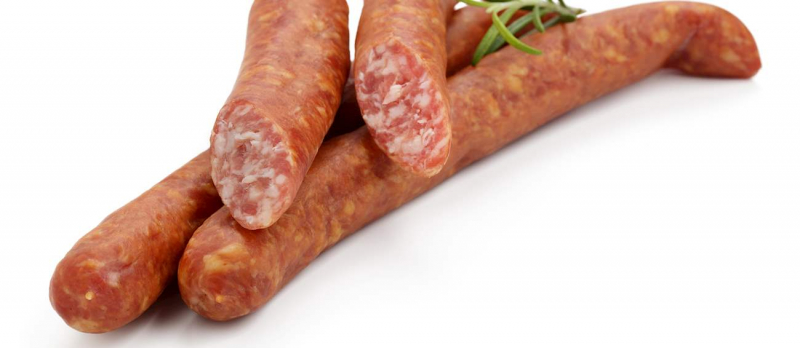
Mettwurst 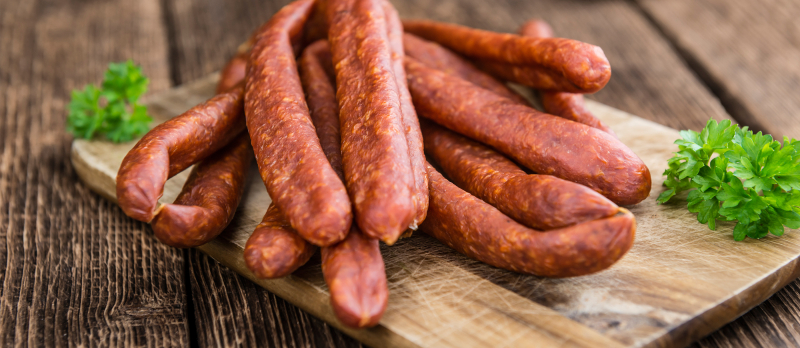
Mettwurst -
It was back in 1805, in Vienna, when Johann Georg Lahner, a butcher from Gasseldorf but trained in Frankfurt, created a new variety of sausage by adding beef to the original frankfurter, which was made exclusively from pork. Initially, his creation carried the name Lahners würstel, but it soon came to be known as frankfurter würstel, which is the name that has stuck until today in Austria.
Considered a variation on the traditional frankfurter würstchen (frankfurter sausage), Wiener Würstchen is a thin parboiled sausage traditionally made of pork and beef in a casing of sheep's intestine, then given low-temperature smoking. The combination is finely chopped and seasoned with spices such as white pepper, coriander, mace, paprika, salt, and ginger before it is placed into a thin sheep intestine, smoked, and parboiled.
In Germany, the sausage came to be known as Wiener Würstchen (meaning Viennese sausage in German), referring to the place where the production of these sausages initially began. Another reason why the Germans had to call these sausages Wiener Würstchen instead of frankfurter sausages, as was the case in Vienna, was because of the protected status that frankfurter würstchen have been enjoying in the country since 1860. These sausages are usually enjoyed in pairs, either warm or cold, and they are typically simply heated in boiling water, roasted, or grilled.
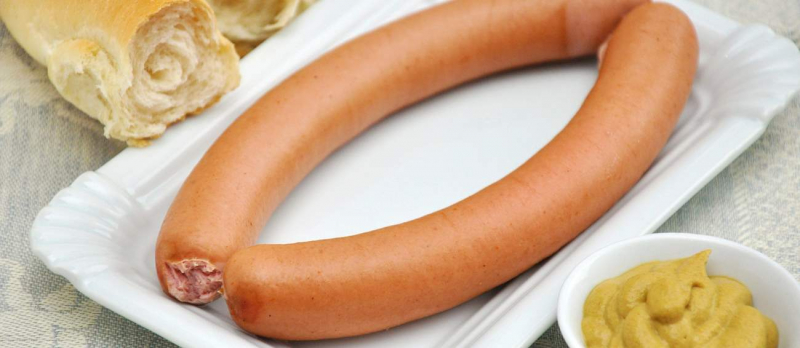
Wiener Würstchen 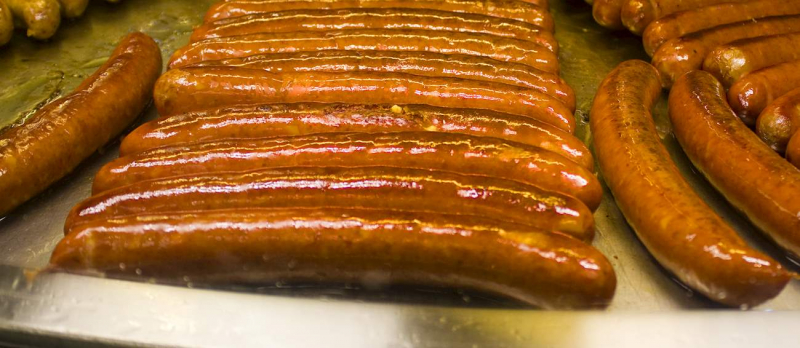
Wiener Würstchen -
As the name suggests, Frankfurter Würstchen is a variety of sausage hailing from Frankfurt, where it has been traditionally prepared for centuries. A Frankfurter is a thin parboiled sausage made of pure pork in a casing of sheep's intestine. The taste is acquired by a method of low-temperature smoking. For consumption, occasionally Frankfurters are not cooked; they are heated in hot water for only about eight minutes to prevent the skin from bursting. From time to time, they cook Frankfurter on a propane or charcoal grill.
Frankfurter Würstchen is boiled and lightly smoked, a process which imparts a pleasant hint of smokiness to this German meat specialty. Since the sausage is pre-cooked, they are traditionally served with mustard, horseradish, bread, or potato salad, and it is often washed down with a glass of fine apple wine (Apfelwein).
Frankfurter Würstchen has been protected in Germany since 1860 when a law passed permitting only those sausages made in Frankfurt and its surroundings to carry the name Frankfurter, whereas other sausage varieties made outside this area, but in the same fashion, were supposed to be labeled as nach frankfurter art (frankfurter-style sausages).
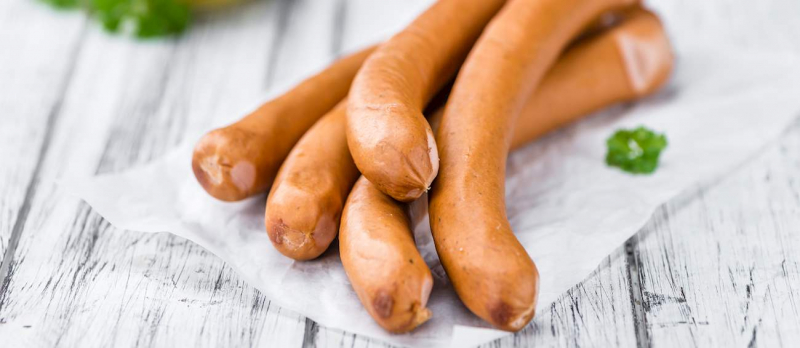
Frankfurter Würstchen 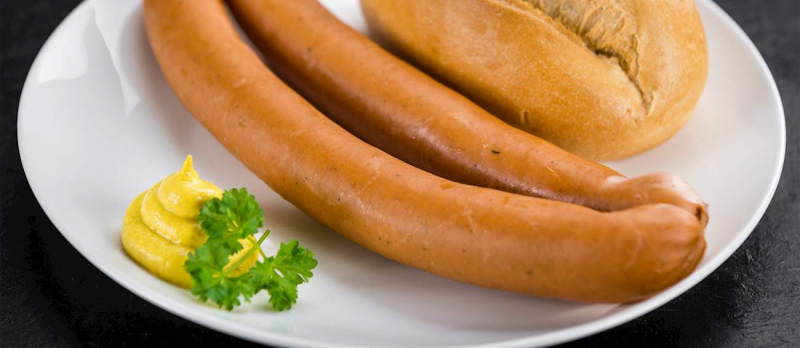
Frankfurter Würstchen













